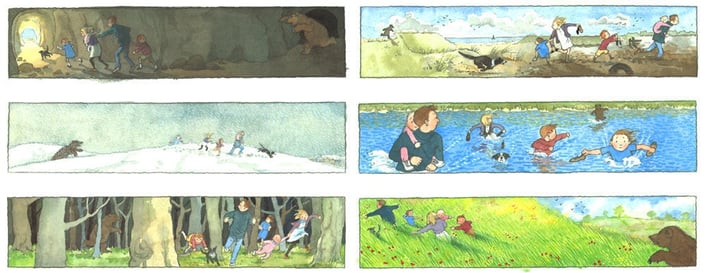Helen Oxenbury (born in 1938) was the stuff of great illustration art from a very early age, according to her father at least. He was the first to encourage his daughter as he saw great talent in the sketches she would pile up in their home in Felixstowe, England.

A Born Illustrator
Helen led a solitary childhood due to the severe asthma that forced her to stay home most of the time. When talking about her young years she evokes her memories of the sky turning a gloomy grey during World War II and of the sound of air-raid sirens looming over the town. She started drawing very early on, as a hobby, but it soon became much more than that and she developed a real passion for it. Her father started picking up books from the library especially for her even though supplies were limited due to the war raging at the time. He was also the one who convinced her to attend the Central School of Art and Design in Ipswich where she met fellow writer and illustrator John Burningham, whom she married in 1964. During vacation weeks she would volunteer at the Ipswich Repertory Theatre workshop where she helped out by mixing paints for set designers, soon deciding she would continue in this line of work herself. It was one of her teachers who pushed her towards becoming an illustrator rather than a costume designer; he told her she was 'much more interested in the character' and she 'ought to go and do illustrations'. He even entered some of her drawings in contests, sometimes without her knowing anything about it. After graduating however, Oxenbury started working as a theatre designer, creating sets and sceneries for plays, films and TV productions. She did not turn to children's books until after she had a child of her own, when she looked for a new line of work that would allow her to stay at home with her baby without having to stop all professional activity. Her husband, who had been writing and illustrating books for a number of years already, also pushed her to create her own stories. Her son, in his younger years, largely inspired the main character in her Tom and Pippo series.
The Finding of an Artist's Voice
From then on Oxenbury continued writing and illustrating children's books and she is very well known for this work today. Among her most famous pieces of work are the adventurous, charming images inspired by locales familiar to her in We're Going on a Bear Hunt (1989), written by Michael Rosen. In this account of the author and the illustrator's respective experiences of the coming to life of Bear Hunt she expresses her gratitude for the absolute freedom Rosen granted her in the creative process of her artwork: 'Michael [...] is the last person to inflict ideas on people: he gave me a free hand. [...] I got so involved I didn't want to break off to show anyone.' Another wonderful example of how versatile her work can be are the downright hilarious illustrations she drew for The Three Little Wolves and the Big Bad Pig (1993), a rewritingby Eugene Trivizas of the popular cautionary tale. Helen Oxenbury won a Kate Greenaway Medal for both Edward Lear's The Quangle Wangle's Hat (1969) and Margaret Mahy's The Dragon of an Ordinary Family (1969), and a second one for a new edition of Alice in Wonderland (1999), which was recently named one of the top ten Greenaway Medal-winning works. She has won several other awards throughout her career including two 'Emil' awards for So Much (1994) and Alice and a British Book of the Year award for Farmer Duck (1991).

If you find Helen Oxenbury's illustrations as lovely and inspiring as we do, then our 2016 Alice's Adventure in Wonderland Family Organiser Calendar will definitely charm you. We also have more Oxenbury for you, in our 2016 Bear Hunt Family Organiser Calendar.
Links
- Want to know more about Bear Hunt? Here is our last blog on the subject with more details on the book's origins.
- For more info on husband John Burningham's work and a peek inside their London home, check out this interesting article.



